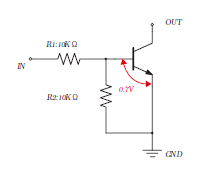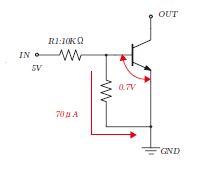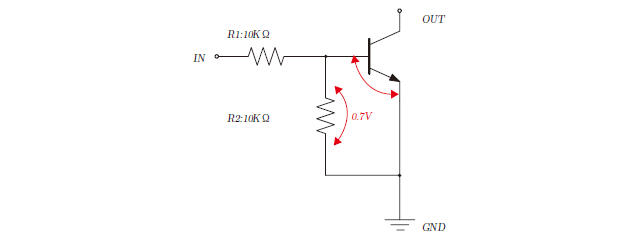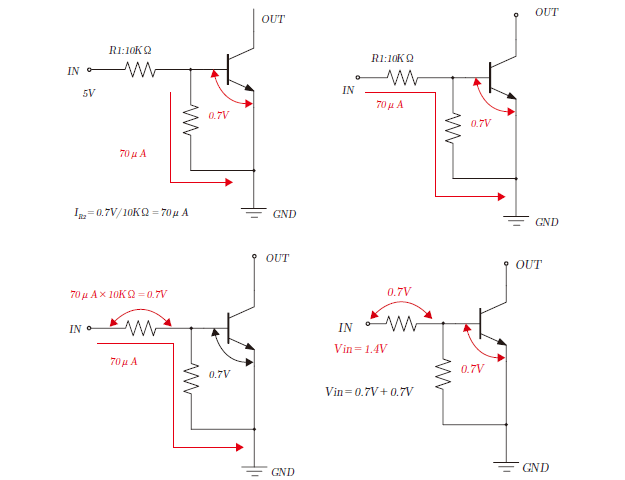43. Computational methods of Transistors With Built-In Resistors
(1)Calculation of base current
We explain the calculation of the base current as follows as digital transistor an example.

It takes a forward voltage (25℃ about 0.7V) between EB since
there is base current flowing in the forward direction
(between EB) between the emitter-base of transistor at the
time of operation of transistor built-in resistor. The same
0.7V is applied on R2 because it is connected in parallel with
Base to Emmitor in transistor with built-in resistor.
Therefore, it is understood that the current of
![]() flows in R2.
flows in R2.

It is understood that voltage of
![]() is applied on both ends of resistor R1 since the potential
difference between Base and Emmitor of transistor is 0.7V, and
the potential of IN terminal is 5V when the input voltage V is
5V. Therefore, it is understood that
is applied on both ends of resistor R1 since the potential
difference between Base and Emmitor of transistor is 0.7V, and
the potential of IN terminal is 5V when the input voltage V is
5V. Therefore, it is understood that
![]() current flows into R1.
current flows into R1.

Therefore, it is understood that
![]() current flows in the base of transistor.
current flows in the base of transistor.

The base current that flows in transistor can be calculated by this calculation. Adjust the output current Io and input voltage Vin so that the output current Io would be less than around 10-20 times of base current that enters into transistor so that transistor with built-in resistor would be properly ON (= to minimize the output voltage Voon).
The forward voltage decreases by about 2.2mV for every 1℃ rise
in the temperature of forward voltage, although the forward
voltage between emitter-base is about 0.7V when the temperature
is 25℃. For example, it becomes around
 when it is 50℃.On the contrary, it becomes around
when it is 50℃.On the contrary, it becomes around
 when fallen in -40℃. In this manner, please note that the
forward voltage Vf varies according to the temperature.
Moreover, the forward voltage of 0.7V for 25℃ is also the
criteria.Please note that there may be about ±0.1 wavering.
Additionally, about ± 30% variation may be in the built in
resistor R1, R2 so the above calculation is considered as the
criteria, and please calculate considering the worst case of
resistor value.
when fallen in -40℃. In this manner, please note that the
forward voltage Vf varies according to the temperature.
Moreover, the forward voltage of 0.7V for 25℃ is also the
criteria.Please note that there may be about ±0.1 wavering.
Additionally, about ± 30% variation may be in the built in
resistor R1, R2 so the above calculation is considered as the
criteria, and please calculate considering the worst case of
resistor value.
(2)Calculation of the lowest necessary input voltage (driving voltage)
It explains the input voltage (driving voltage) necessary to turn ON the transistor with built-in resistor as follows considering actual transistor with built-in resistor as an example.

Voltage between EB=forward voltage between EB:About 0.7V=Voltage applied on both terminals of R2 is formed when forward current flows between the EB at the time of operating the transistor with built-in resistor.
The forward voltage (25℃, about 0.7V) is applied between EB
because the base current flows to the forward direction between
emitter-base of the built-in transistor (Between EB) when the
transistor with built-in resistor operates. The same 0.7V is
applied on R2 because EB interval and resistor R2 of the
built-in transistor are connected in parallel with the
transistor with built-in resistor. Therefore, it is understood
that
![]() current flows into R2.
current flows into R2.
70μA that flows to this R2 flows also flows into R1. Therefore,
it is understood that the
![]() voltage is applied on both terminals of R1. So it is understood
that the input voltage of total 1.4V is necessary to ON the
transistor with built-in resistor, by matching 0.7V between EB
of a built-in transistor with this 0.7V of R1.
voltage is applied on both terminals of R1. So it is understood
that the input voltage of total 1.4V is necessary to ON the
transistor with built-in resistor, by matching 0.7V between EB
of a built-in transistor with this 0.7V of R1.

Therefore, if we generalize the voltage Vion that let transistor
built-in resistor turn ON, it becomes
![]() considering the forward voltage as Vf. As a result, it is
understood that the ON voltage of transistor built-in resistor
is decided by the ratio of R1 and R2.
considering the forward voltage as Vf. As a result, it is
understood that the ON voltage of transistor built-in resistor
is decided by the ratio of R1 and R2.
Actually, besides the above mentioned driving voltage having a
variation of about 20-30% due to the variation of resistor value
ratio and Vf, so please design by maintaining a perfect margin
for actual use because there is also fluctuation by the change
in temperature as a criteria.To be precise, please calculate
considering about
![]() when the output current is about 100μA, and about
when the output current is about 100μA, and about
![]() when the output current is about 1mA in 25℃.
when the output current is about 1mA in 25℃.
The voltage calculated above is the voltage to initiate turn ON a transistor. The required voltage to have certain amount of curreent flow is larger because it is neccesary to draw current of about 1/20 or more of the output current into the base through built-in resistor. Similar calculation is concluded for the pnp type because it is almost the same value of Vf althought the above example is for the npn type.
